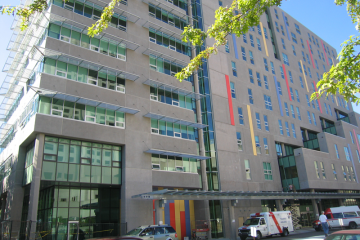MedIT has successfully renewed the videoconferencing equipment in three rooms at the Gordon and Leslie Diamond Health Care Centre (GLDHCC) for the Faculty of Medicine. The year-long project was pulled off almost unnoticed by faculty, students, and other MedIT customers. But sometimes being unnoticed is a good thing.
 The GLDHCC is the busiest videoconferencing site in the Faculty, with nearly two and a half times more videoconferencing hours than any other site in 2012. With these rooms in such high demand, it was a challenge to complete the videoconferencing equipment renewal without any service interruption. The project was planned in such a way that convenient alternate locations were available for classes, meetings, and academic rounds during the renewals.
The GLDHCC is the busiest videoconferencing site in the Faculty, with nearly two and a half times more videoconferencing hours than any other site in 2012. With these rooms in such high demand, it was a challenge to complete the videoconferencing equipment renewal without any service interruption. The project was planned in such a way that convenient alternate locations were available for classes, meetings, and academic rounds during the renewals.
Preventing future interruption of videoconference services was also a key driver behind the project. Replacing equipment before the end of its life greatly reduces the chances that people will be affected by equipment failure in the future. There are, however, some technological changes that customers should notice. The renewals enhance:
- Collaborative learning: These rooms now have a multi-microphone set up, meaning that the presenter can enable more than one microphone in the room to be active at the same time. This set up is designed to allow conversations to happen more naturally in classroom and meeting settings, as participants do not have to release their microphone to allow another participant to respond. It also ensures that participants in all locations have full access to what is being discussed.
- Engagement: A third visual output was added so that the presentation, the presenter, and participants asking questions in the GLDHCC can be seen simultaneously on one screen. Now participants in other locations can see interactions between the presenter and participants as they happen at the GLDHCC.
- Presenter capabilities: Annotation tablets are included in all three rooms, allowing presenters to “draw” on their presentation slides. The seminar rooms also include larger confidence monitors – screens at the back of the room that allow the presenter to see their presentation and the video of themselves.
The rooms are also equipped with new high-definition displays which, in addition to delivering a better quality image, significantly reduce the cost per unit for the Faculty of Medicine.
Videoconferencing is a vital component in ensuring that students receive the same educational experience, regardless of their location. Videoconferencing equipment renewal is just one way that MedIT is helping to maintain the health of UBC’s distributed medical program.
For more information about videoconferencing usage in the Faculty of Medicine, and for training resources, visit the MedIT Service Catalogue.